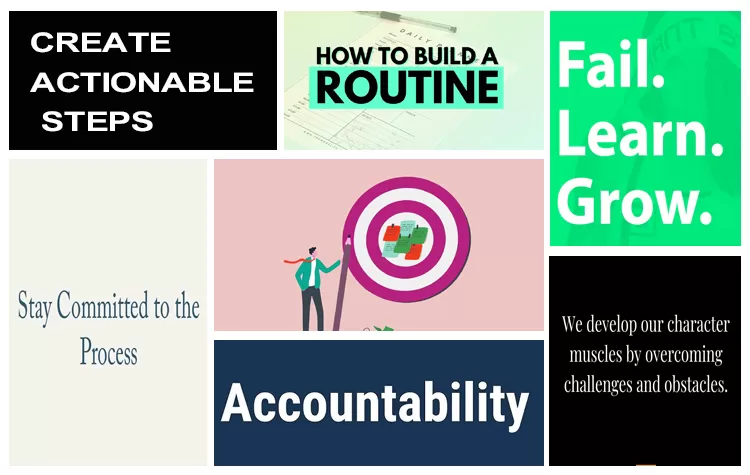Setting and achieving goals is immensely perceived to be positive to the development of one at a personal and occupational level. Generally, most people cannot achieve objectives. However, the utilization of appropriate strategies and approaches shall allow you to achieve your set objectives within a period of less than six months. For this paper, utilizing the aid of these steps, you shall attain your desired outcomes.
1. Clear and Specific Setting of Goals
A. Use the SMART Criteria
- Specific: Clearly say what you want. For instance, "I want to be fit" should be reworded to "I want to be able to run a 5K."
- Measurable: Use measurable numbers that help reflect your progress, for instance, "I want to lose 10 pounds in six months."
- Achievable: Ensure what you set for yourself as your goal is within your capability so that you do not end up frustrated in the long term.
- Relevant : It aims to align your goals to your values and long-term wants and makes them more motivating.
- Time-bound : You can set a deadline for your goal, such as setting a six-month deadline and sticking to it.
2. Break Down Your Goals into Smaller Milestones
A. Create Actionable Steps
- Breaking Up Your Goals: Break down the major goal into very minor, achievable steps for you. For example, if your target is to save $6,000 within six months, then one goal to target would be an accumulation of $1,000 within each given month.
- Targets for a Week or Two Weeks: Divide it even more to ensure you do not lose focus and get geared up week after week or fortnight after fortnight.
B. Use a Planner or Digital Tools
- You use a planner, calendar, or goal-tracking app to track where you are and have more visual purposes to organize tasks and milestones.
- It should have reminders and alerts on time to update deadlines that help one keep themselves accountable.
3. Develop a Routine
A. Establish a Consistent Schedule
- Daily Habits: Dailies: Your sub-goals of what you want in your top goal should form part of your daily routine. For instance, if you want to read more, then you will find the time to read for 30 minutes in the day.
- Time blocking: You commit to specific time blocks for your key objectives and mark these as Non-Negotiable Appointments that cannot be scheduled or rescheduled.
B. Stay Flexible
- Adapt as Needed: Life can be unpredictable, so adjust your schedule when needed to maintain momentum and avoid feeling overwhelmed.
4. Maintain Accountability
A. Share Your Goals
- Accountability Partner: Share your goals with a trusted friend, family member, or mentor and empower his or her role in helping him stay on track.
- Group Partner: Partner with people or a community who share your desired outcomes to keep you motivated and whom you can share your experiences.
B. Regular Progress Reviews
- Weekly Surveys: Commit an hour each week to recording the time that will inform you of things changing or improving.
- Celebrate Trends: Celebrate your successes; this develops a habit in you, and eventually, motivation to do more builds up.
5. Motivate Your Self And Overcome Obstacles
A. See Yourself Achieving Success
- Create a Vision Board: Be sincere about images, quotes or pictures that could represent your wishes and bring them to the front of your mind.
- Positive Affirmations: Utilize positive affirmations which would reinforce your self-confidence so you will find out more about yourself.
B. Expect Obstacles
- Possible Obstacles: Imagine likely obstacles that you might foresee and brainstorm ways you would somehow solve them in order to overcome
- Self-Sensitivity: Treat yourself with kindness when obstacles do intervene on your path and once again to focus your mind towards your goals
6. Learn and Grow Forever
A. Invest in Yourself
- Education and Skill Building: Books, courses, or workshops on a skill or knowledge that could bring you closer to your goal.
- Seeking Feedback: Asking for any suggestions from a mentor or peer about the way you are doing it so that you may learn to adjust and get back on track.
B. Reflection of the Way
- End-of-Month Reviews: Reflective check-up on what you have been doing each month with what you have done right and where you can do better
- Tapped Challenges as Lifesavors: Leverage the mistakes in your plan for the next event.
7. Stay Committed to the Process
A. Develop a Resilience
- Be Obsessed about Your 'Why': Redefine why you must achieve that goal as a reminder of what you need to eagerly await and what keeps you going in the rough times.
- How to develop a growth mindset: learn to perceive obstacles as a mean to get you to become better, which makes you more resilient.
B. Practice Patience
- Take Your Time: Often, very much effort taken with much time being involved is necessary for quite some progress to come by. Be patient, keep in mind what you're looking to achieve in the long run, and stay on your track.
Conclusion
In case I can get my set objectives done within the next six months, then yes, I can do this. Firstly, before one can clearly set goals, the goals should be specific from any given angle. Then smaller steps toward becoming effective in all matters related to your objective. Thirdly, people will be held accountable in case there is failure to achieve set goals. Fourthly, corrective measures as regards change. Keep on focus, learn from your experiences and celebrate your successes along the road. Persistence and dedication will surely make you attain your dreams!
